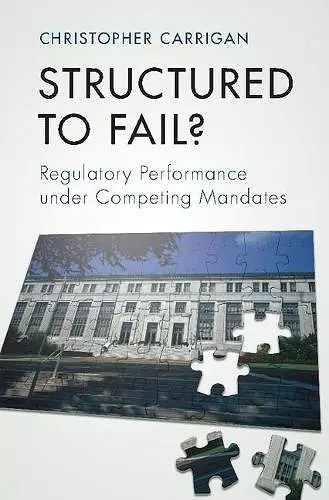Structured to Fail?
Regulatory Performance under Competing Mandates
Format:Hardback
Publisher:Cambridge University Press
Published:26th Jun '17
Currently unavailable, and unfortunately no date known when it will be back
This hardback is available in another edition too:
- Paperback£33.99(9781316632802)

This book employs a diverse set of research methods to confront widely accepted principles of regulatory agency design.
Carrigan systematically challenges accepted principles of regulatory design by combining a statistical analysis of a broad set of US agencies with an in-depth case study of the role of the Minerals Management Service in the 2010 Gulf of Mexico oil spill to develop important conclusions for policy.In the search for explanations for three of the most pressing crises of the early twenty-first century (the housing meltdown and financial crisis, the Gulf oil spill, and the nuclear disaster at Fukushima), commentators pointed to the structure of the regulatory agencies charged with overseeing the associated industries, noting that the need to balance competing regulatory and non-regulatory missions undermined each agency's ability to be an effective regulator. Christopher Carrigan challenges this critique by employing a diverse set of research methods, including a statistical analysis, an in-depth case study of US regulatory oversight of offshore oil and gas development leading up to the Gulf oil spill, and a formal theoretical discussion, to systematically evaluate the benefits and concerns associated with either combining or separating regulatory and non-regulatory missions. His analysis demonstrates for policymakers and scholars why assigning competing non-regulatory missions to regulatory agencies can still be better than separating them in some cases.
'In skillfully presenting new theoretical and empirical findings, Christopher Carrigan persuasively challenges long-standing principles about how to organize the many regulatory authorities that oversee business behavior. This innovative book represents the most definitive treatment of the opportunities and challenges involved in structuring the missions and jurisdictions of government agencies. With careful analytical execution and often counterintuitive insight, Carrigan offers a major advance in the study of regulatory politics and public administration, with critical insights for scholars and policymakers alike.' Cary Coglianese, Edward B. Shils Professor of Law and Professor of Political Science, and Director of the Penn Program on Regulation, University of Pennsylvania
'Christopher Carrigan has produced the rarest of social science achievements: theoretically grounded, empirically rigorous scholarship that carries indispensable lessons for policymakers seeking to solve the toughest, most salient issues confronting the world today. This book should cause both researchers and practitioners to seriously reconsider what they think they know about government organizations (like the Minerals Management Service prior to the Gulf oil spill) that combine regulatory and non-regulatory objectives.' Steven J. Balla, Associate Professor of Political Science, Public Policy and Public Administration, and International Affairs, The George Washington University, Washington, DC
'Whether caught between prudential regulation and consumer protection in financial policy, between foods and medicines in health regulation, or between licensing and safety in the governance of mining, government agencies have multiple, often conflicting jobs to do. Christopher Carrigan has written the best study of this problem, one of the principal crises facing American government in this century. A necessary read for policymakers and students of government alike.' Daniel Carpenter, Allie S. Freed Professor of Government, Harvard University
'In this very interesting book, Carrigan explores the relationship between organizational design and regulatory performance. Can we design regulatory agencies to be more effective? When does it make sense to limit agencies to one key task and when to give agencies multiple missions? Deftly mixing careful theorizing and empirical research, Carrigan explains why some regulatory agencies perform poorly and what, if anything, we should do about it. It is an impressive accomplishment and a must read for those interested in regulatory politics, public administration, or public sector performance.' David E. Lewis, Chair, William R. Kenan, Jr. Professor, Department of Political Science, Vanderbilt University
'In this sophisticated yet readable volume, Professor Carrigan uses front page news events like the Deepwater Horizon spill to address important questions of government agency behavior. He highlights the crucial conclusion that seemingly obscure decisions, like how agencies are organized, can have important impacts on public policy outcomes.' Stuart Shapiro, Professor and Director, Public Policy Program, Bloustein School of Planning and Public Policy, Rutgers University, New Jersey
'Carrigan brings a deep statistical understanding of what drives successful agencies and the realization that goal ambiguity alone didn't cause regulatory failure.' Sam Batkins, Regulation
'Overall, this book is an invaluable resource for scholars and practitioners of political science, risk analysis, public policy, and public administration.' Zhoudan Xie, Risk Analysis
'Carrigan has … offered a hypothesis ready for empirical inquiry, and one that regulatory scholars are well advised to take up. The contemporary political context suggests that such research stands to make theoretically meaningful and substantively crucial contributions.' David P. Carter, Journal of Public Administration Research and Theory
ISBN: 9781107181694
Dimensions: 235mm x 158mm x 22mm
Weight: 600g
334 pages